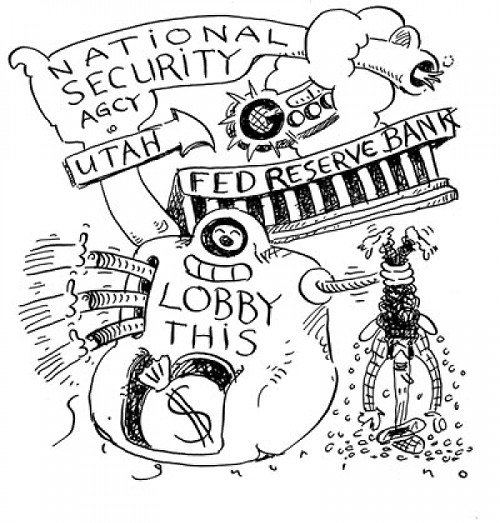The Straight Dope columns I find particularly interesting are the ones about secret societies: the Illuminati, the Bilderbergs, the Council on Foreign Relations, the Trilateral Commission, the Masons, etc. I’m not sure whether I should beat ’em, join ’em or continue to relegate them to the land of paranoid delusions. Can you give me the Straight Dope? —John La Duke
You’re missing the big picture, John. Sure, I could riff on the Illuminati, Skull & Bones or the League of Hyrax—or I could tell you about the more insidious secretive societies that hide in plain sight. These organizations are far more dangerous than a bunch of balding ex-frat brothers sitting around naked in the woods plotting world domination. They work right out in the open, knowing the average person can’t fathom how deep the swamp really is.
Let’s start with the many secretive entities on the federal payroll, perhaps the most infamous being the National Security Agency. Every day, NSA robosnoops intercept at least 1.7 billion e-mails, phone calls and other electronic communications, looking for ... well, we don’t know exactly, because no one is talking. We also don’t know the size of the NSA’s budget; its share of the $53 billion U.S. intelligence kitty is classified.
But, evidently, they get a good chunk. In October, a heavily fortified top-secret NSA data center costing $1.5 billion will go into operation in Utah. Projected by some to consume $40 million in electricity per year, this mega installation has enough capacity to store hundreds of times the amount of data created in all human history. The idea is to protect us against terrorism and such. But who can say when some mid-level bureaucrats may take it into their heads to investigate the Tea Party, the Socialist Workers or you?
Closely linked to the NSA is the vast anti-terrorism and homeland security apparatus erected after 9/11. A 2010 Washington Post investigation found 1,271 government organizations and 1,931 private companies were toiling away at various domestic security initiatives. Thirty-three buildings totaling 17 million square feet had been constructed in the D.C. area to house all those worker bees. What are they up to? Even the people at the top of the intelligence food chain don’t really know.
Another secretive agency is the Federal Reserve, which controls U.S. banking and monetary policy. The Federal Reserve’s deliberations are closed to the public, and its bylaws and codes of ethics are also secret. The idea is to prevent the intrusion of politics, but stuff happens. A recent General Accounting Office report noted that a New York Fed director had bought Goldman Sachs stock while the firm was receiving $12.9 billion via a bailout the Fed had engineered.
Finally, the most insidious secretive society of all—lobbyists. They don’t work for the government; typically they’re former government employees who put their insiders’ contacts and knowledge at the service of whatever private interest is willing to pay their steep rates. How steep? For a crude idea, divide the estimated $3.3 billion 2012 lobbying tab by the 12,400 known lobbyists, for an average of $266,000 per lobbyist. Acquiring votes ain’t cheap.
Who pays that kind of money? The National Rifle Association at $3 million is a piker compared to the U.S. Chamber of Commerce, No. 1 at $136 million. The rest of the top five might seem noncontroversial—the National Association of Realtors, Blue Cross/Blue Shield, General Electric and the American Hospital Association. But think: What businesses are these people are in?
Still, we need to look at the even bigger picture. An enduring belief among progressives, clung to more fervently than ever in the age of WikiLeaks, is that greater transparency = better world. This is inarguably true of information. Your columnist and his henchpersons luxuriate in the ability to jack into open databases and download everything from federal homicide investigations by criminal code subsection to Chicago Transit Authority daily rail ridership by stop.
But transparency of decision-making is something else. In a TED talk from February, Harvard professor and political activist Larry Lessig observes that U.S. elections are a two-stage process: in stage one, the people with big bucks decide who the rest of us will get to vote for in stage two, namely the official elections.
In the manner of all TED lecturers, Lessig offers no useful guidance on how this process might be reformed, and at a fundamental level, it can’t be. We live in a world of infinite possibilities; the body politic is equipped to choose among two or three. Reducing the pile from the former state to the latter is inevitably accomplished behind closed doors by a jostling mess of lobbyists, operatives, moneyed interests, do-gooders, harried bureaucrats, politicians of varying intelligence, integrity, guts and other interested parties.
I’ve participated in this shadowy process myself. Occasionally, afterward, I go to the public meeting at which the matter is nominally decided, or more often ratified (I live in Chicago, OK?), and I think: Most of the people in this room have no clue.
Send questions to Cecil via StraightDope.com or write him c/o Chicago Reader, 350 N. Orleans, Chicago 60654. Subscribe to the Straight Dope podcast at the iTunes Store.
More by Cecil Adams
-
This Is the End, My Friend
This week's Straight Dope marks the last appearance of the column as the Teeming Millions have known it for the past 45 years.
- Jul 11, 2018
-
Do Brain Supplements Do Anything?
Brain Drain
- Jul 4, 2018
-
Is flying really worse for the environment than driving?
Planes and Trains
- Jun 27, 2018
- More »




